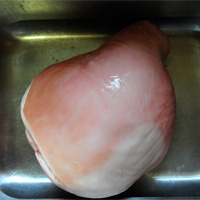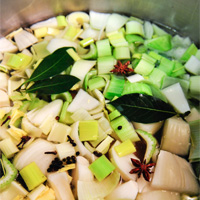Holiday Ale Cured Ham
 How to make Holiday Ale Cured Ham.
How to make Holiday Ale Cured Ham.
Pigs are wonderful animals, plain and simple. They are a canvas that so many different products are created from. Take a ham for instance. The hind legs from the hip to the shank can be just roasted to have a great leg of pork roast, or taken to a whole new level of flavor by first curing it to create a ham.
You can do a dry cure, where salt, seasonings and pink salt are combined, rubbed onto the skin and left to sit a day per pound to pull out moisture from the muscle and create edible delights like: Belgian Jambon d’Ardenne, French Bayonne ham, Italian prosciutto, German-smoked Black Forest Ham, Spanish Jamón Serrano or Jamón ibérico, or an English York ham. These hams can take months to years to cure properly, at a consistent temperature and humidity, making them very hard to replicate in the home kitchen. Plus some of the pigs were fed special diets to impart delicious flavors that aren’t as easy to procure.
The second type of ham is a wet-cured ham: boiled hams, spiral cut hams and deli hams. These hams are soaked or injected with brine that cures it, transforming the muscle into a delicious meat. This is the easiest of the hams to make at home because you just need the time and refrigeration space to help the transformation of flavors happen.
Here is a recipe and the ‘how to’ instructions to make your own house-cured Holiday Ale Cured Ham, cuisine à la bière style. After the pork leg is cured, it can be boiled to make a ‘City Ham’, roasted or smoked. This recipe will teach you all three cooking techniques. To create a glazed ham, check out my recipe for a Beer Mustard Glazed Ham.
Note on curing salt: This ingredient could be left out, but the results of the finished ham will change. The sodium nitrite prevents botulism issues and keeps the meat from spoiling as it cures for 2 weeks. This ingredient combined with the salt and sugar will also help prevent microorganism growth. Plus, the pink salt helps keep the meat a rosy pink color when cooked, as opposed to a white | gray color that would be traditional for a roasted pork leg.
Makes: 1.75 gallons of brine | cure for Holiday Ale Cured Ham
Special Equipment:
1 each Cambro 22 qt Polypropylene Food Storage Container
1 each Thermapen Instant Thermometer
and | or
1 each ChefAlarm by ThermoWorks
1 each All-Clad Stainless Steel Large Roti Combo with Rack and Turkey Lifters
Adapted from BeerAdvocate Magazine: Cuisine à la Bière | Dec 2012 | Issue #71
Check out my other Holiday Feast ideas, menu suggestions and recipes.

| Servings | Prep Time |
| 14 guests | 15 minute |
| Cook Time | Passive Time |
| 7 hour | 14 days |
|
|

|
Here is a recipe and the 'how to' instructions to make your own house-cured ham, cuisine à la bière style. After the pork leg is cured, it can be boiled to make a 'City Ham', roasted or smoked.
|
- 2 quart water
- 2 1/2 cup sugar, dark brown
- 2 cup salt, kosher
- 1 1/2 cup honey local variety | wildflower | orange blossom
- 1/2 cup molasses black strap variety
- 2 tablespoon salt, curing or pink, available at
- 30 each cloves, whole
- 9 each bay leaves preferably fresh
- 2 each star anise pods
- 4 pound ice
- 72 ounce Jubelale, from Deschutes Brewery or other Winter Warmer
- 18 - 23 pound pork leg, hind leg or ham leg, with the shank end attached
- 3 each celery, stalks, washed and chopped
- 6 each cloves, whole
- 3 each bay leaves preferably fresh
- 2 each onion, yellow, large, peeled and quartered
- 2 each leeks, white and light green part, cut in half, washed and chopped
- 2 each star anise pods
- 1 each cinnamon stick, whole
- 1 each tangerine, or other citrus, cut into quarters
- 1 teaspoon peppercorns, black whole
- 5 each carrots, large peeled and chopped
- 24 ounce Jubelale, from Deschutes Brewery or other Winter Warmer
- 12 ounce Jubelale, from Deschutes Brewery or other Winter Warmer
- 1 recipe Beer Mustard Glazed Ham, optional, recipe here
- In order to fully cure the hind leg, the meat needs to be submerged for at least 14 days or approximately one day for every two pounds of meat weight. Make sure there is space in a refrigerator or a kegerator that can be held at 40°F | 4°C or below. Even with the curing salt (sodium nitrite), the meat can spoil if not kept cold.

- In a large stock pot, combine the water, brown sugar, salt, honey, molasses, pink salt (sometimes called curing salt), cloves, bay leaves, cinnamon sticks and star anise. Bring to a simmer over high heat for 10 minutes to dissolve the sugar | salt and to infuse the flavors into the brine. Turn off the heat and let the brine cool for 10 minutes. Do not strain the brine, as these other ingredients will leach out their flavor and impart it into the finished ham.

- If using a large stock pot or homebrew kettle to brine the pork leg in, add the ice and cold Jubelale to the slightly cooled liquid. Stir well to combine the ingredients and cool the mixture down to at least 40°F | 4°C. Make sure there is enough room for the pork leg to be fully submerged, taking care that water displacement does not overflow the pot (this shouldn’t be a problem with a 10-gallon brew pot). Cover with a lid and place into the refrigerator or kegerator undisturbed for at least 14 days. Once every few days, turn the pork leg around to make sure it has full contact with the brine | cure. It will take this long to infuse the brine deep into the meat, all the way to the bone.

- If using another large container to brine in, such as a Cambro 22 qt Polypropylene Food Storage Container
or otherfood-grade 5-gallon bucket with a lid, add the ice and cold brew to the pot, cooling the brine down below 40°F | 4°C. Then place the pork leg into the container and carefully pour the brine over the meat to cover.

- After the two weeks have passed, remove the container from the cold storage and take out the now-cured pork leg from the brine | cure. Discard any spices or bay leaves that might be stuck to the meat. Do not use the brine/cure again; it has served its purpose.

- Now, the choice is how to cook the ham.
- Add the vegetables to the pot with the pork leg (inserting a probe thermometer
) and cover with enough water to fully submerge the leg by 6 inches, about 2 – 3 gallons of water along with the Jubelale or Winter Warmer. Bring the liquid to a boil, then turn down the heat to a simmer (just barely boiling) and cover with a tight-fitting lid. After 30 minutes, check the liquid and skim any foam or impurities that make a scum on the surface of the water. Cover and let cook for 3 hours. Add the carrots, checking the liquid level to make sure the meat is still fully submerged and cook until the internal temperature of the ham is 155°F | 68°C. Traditionally, the pork leg is cooked 20 – 25 minutes per pound of meat (depending on how thick the meat is and the fat-to-muscle ratio). For a ham of about 20 pounds, that equals about 6.5 – 7 hours of total cooking time. I suggest using a probe thermometer
that can be left in the meat, so you can set a temperature that will trigger an alert. Be sure to position the probe in the thickest part of the muscle, away from any bone contact to prevent a false temperature reading.

- Once the internal temperature of 155°F | 68°C is reached, turn off the heat and remove the lid. Allow the pork to cool for at least an hour and up to 2 hours in the pork stock, before trying to remove it from the pot. Carefully remove the leg using clean dish gloves to get a better handle on the meat and have a sheet tray or roasting pan next to the pot to set the leg in. Once removed, use kitchen shears to cut the skin off the leg and discard it. You may leave the fat as is or trim it off with a small paring knife.
- Taste the remaining pork stock. If it is too salty, discard. If it has a nice flavor, save the stock and use it to cook beans, pearl barley, lentils, split peas, or use for soup base. The now-cooked ham can be served to guests on a platter and sliced. Or the ham can be cooled, refrigerated and used for any ham recipe. The boiled ham can be made a day or two ahead of when it is going to be served.
- To reheat the ham, follow the directions for a Roasted Ham, but figure 10 - 15 minutes per pound to reheat the already cooked ham, cooking it at 325°F | 163°C, looking for an internal temperature of 150°F | 66°C, as the carryover heat will raise it to 155°F | 68°C before you serve it.

- An alternative version of this recipe can be made using the Beer Mustard Glaze recipe and finishing the recipe as described in the directions.
- Preheat the oven to 325°F | 163°C. Rinse off the brine and cured ham, and then pat dry with paper towels. Place the leg of pork, skin-side up, into a roasting pan fitted with a roasting rack. Add 3 cups of water and another 12 ounces of Jubelale (or other Winter Warmer) to the bottom of the roasting pan. Position a probe thermometer
into the thickest part of the ham. Tent the pan with aluminum foil and place into the center of the oven, leaving the temperature sensor outside the door. Roast the ham for 25 - 30 minutes per pound. One can raise the temperature to speed up the cooking process, but the results are not as good.
- After about 2.5 hours, remove the aluminum foil tent (reserving) and leave the roast uncovered. Check the liquid content of the bottom of the roasting pan and add more water if needed. Once the temperature reads 155°F | 68°C, remove the ham from the oven and re-tent with the foil.
- It is important not to overcook the ham, as it will begin to dry out. Let the ham rest for at least 30 minutes, as the carryover heat will continue to cook the ham, raising the internal temperature of the meat to 160°F | 71°C, then cooling the muscle, allowing the juices to redistribute. Using kitchen shears, cut off and remove the skin, as it is inedible at this point. Slice the ham into thin slices, basting the slices with the pan drippings and serve. The roasted ham can be made a day or two ahead of when it is going to be served.

- An alternative version of this recipe can be made using the Beer Mustard Glaze recipe and finishing the recipe as described in the directions.
- Preheat the smoker to 250°F | 121°C using a fruit wood, such as cherry, apricot or peach. Place the brine/cured pork leg into the smoker with a water pan filled with 12 ounces of Jubelale or other Winter Warmer and the same amount of water. Minimize the amount of times the smoker is opened—keeping a consistent temperature will result in a better ham, while using a probe thermometer
to monitor the internal temperature of the ham remotely. Smoke the ham until it reaches an internal temperature of 155°F | 68°C, at least 14 hours of cooking time.
- Remove the ham from the smoker and let rest (covered with aluminum foil) to collect its juices for at least 30 minutes before carving. The smoked ham can be made a day or two ahead of when it is going to be served.
 As Deschutes Brewery brews Jubelale as a seasonal release, I have saved a 6 pack and aged it in my cellar for the next years Holiday Ale Brine. Each year they change the artwork for the label. The flavors from aging intensify the malt complexity, while the hops further drop from the flavor profile.
As Deschutes Brewery brews Jubelale as a seasonal release, I have saved a 6 pack and aged it in my cellar for the next years Holiday Ale Brine. Each year they change the artwork for the label. The flavors from aging intensify the malt complexity, while the hops further drop from the flavor profile.




